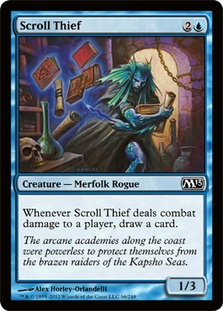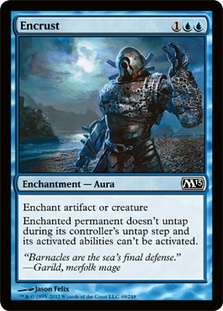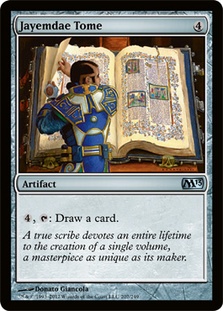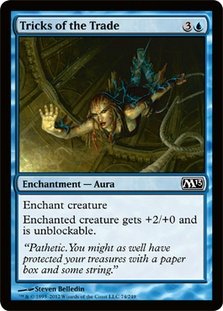By the time most of you read this, the first World Magic Cup will be underway. The successor to the team competition that took place at the now-defunct World Championships, the World Magic Cup provides the chance for players to represent their countries in a fashion unlike any of the other high-level tournaments. It seems only fitting that the very first World Magic Cup comes on the heels of the summer Olympics, with the tides of national pride still swollen. I’m hardly the flag-waving, "U-S-A! U-S-A!" chanting patriot type, but I’ve always gotten into the spirit of things during the team competition. I’m thrilled to have the opportunity to represent the United States on the world stage.
Nationals was always one of my favorite tournaments, and I was sad to see it go. I had a string of almost-but-not-quite finishes at Nationals over the years. In 1997, Nationals was nearly my breakout event. That year, I won the very last US Open qualifier—the original "grinders," called such since they were non-stop single-elimination tournaments run up until the start of Nationals that allowed unqualified players to secure themselves a spot. Competitors were just chewed up and spit out by the events. After fighting my way into Nationals through one of the grinders, I fell just short in the tournament itself, losing my last round playing for Top 8 in the Buried Alive mirror against Jeff Butz, who ultimately went on to join Justin Gary, Kyle Bigos, and Bob Maher on the US National team that year.
My near miss finishes at Nationals continued. In three consecutive years starting in 2002, I finished 12th, 6th, and 6th, missing Top 8 on tiebreakers the first time and following that up with two heartbreaking losses in the quarterfinals when only the Top 4 made the team. I had the dubious honor of being a member of what many have called the best bottom half of a Nationals Top 8 ever, with me, Jon Finkel, Mike Turian, and Neil Reeves all getting knocked out in the quarters in 2004. Suffice it to say that my experiences at Nationals were trying, to say the least.
My history with Nationals makes my position as US Team Captain this year rather amusing. As soon as there’s no more tournament to determine the National Champion, I can manage to make it. Similarly, last year was the first time I’d ever been in the lead of the Player of the Year race at any point, and it was also the year they stopped awarding the title to the top Pro Point finisher. Clearly changes in the rules favor me.
No matter how I got here, I’m happy I made it. I’m writing this from my hotel room in Indianapolis, where I’ve been spending the evening testing with the rest of the US team: Luis Scott-Vargas, Alex Binek, and Joe Pennachio. As this article is going to be posted before the event actually starts, I’m not going to be able to share the details of our testing with you, but I will share my thoughts on the process.
The World Magic Cup is an awkward event for large countries like the United States. I’ve heard quite a bit about the teams from other countries getting together to playtest in the weeks leading up to the event, and that just hasn’t been realistic for us. In fact, the nature of the WMCQ system pretty much necessarily makes that the case, since the three qualifiers were all in distant regions of the country. Unsurprisingly, qualifiers run in California, St. Louis, and Baltimore led to a team with members from the West Coast, Midwest, and East Coast. Testing together in person beforehand just doesn’t work when you live thousands of miles apart.
Thankfully, we live in the future and have such wonderful technology as the Internet. Once the team roster was finalized, I made a Facebook group for testing discussion. It was largely dormant for a while, but once M13 came out and event results started rolling in, we got to discussing Standard and what decks we liked and which we didn’t.
One interesting wrinkle of the World Magic Cup format is cutting the player with the lowest point total for the second day of competition. The trio of Constructed formats used on Day 2 and the fact that you don’t know who is going to be cut means that each player needs to be prepared to play multiple formats. This makes the tournament one of the most difficult to prepare for—not only does every player have to be ready to play Standard and M13 Draft on Day 1, but optimally they need to be prepared to play at least one of Modern or Block on Day 2—o say nothing of actually testing Team Limited.
With our limited ability to test beforehand, we decided that the best way to handle the situation was for Alex and Joe to pick a format they wanted to play and LSV and I would be prepared to cover all of them. With GP Anaheim and GP Columbus not long ago, both of us had recently played both Block and Modern, and it wasn’t a huge stretch for us to refamiliarize ourselves with the formats. This plan certainly wasn’t optimal, since it largely left us to test on our own rather than having focused preparation for each format. I will say that the majority of our testing has been focused on Standard and M13 Draft, though, and I wish we’d had more time to commit to the additional Constructed formats.
That said, Standard and M13 Limited are the most important formats to prepare for in the tournament. On Day 1 everyone has to play both formats, the results of which lead to seeding on Day 2. The second day begins with M13 Team Limited—a format for which M13 Draft preparation is quite valuable—and then the Team Constructed rounds include Standard as a third of the results. To even get the chance to play Modern and Block, we need to post a strong collective record in Standard and M13. Once we get to the Team Constructed rounds, Modern and Block together are more important than Standard, but until that point the balance is skewed infinitely in the other direction.
Thankfully, both the Modern and Block formats are relatively well known at this point, so even with relatively low preparation we’re likely to be okay. The fact that all of the Constructed formats are well into their lifespans is something that makes preparing for a tournament like this even possible. I’ve seen some players complain that the World Magic Cup is coming at the tail end of old formats, so it’s harder for players to show up with something entirely new. Sure, timing it similarly to a Pro Tour might be more exciting, but can you imagine actually trying to prepare for three new Constructed formats on top of a brand new Draft format? I actually feel like the existing window between set releases and Pro Tours is already too short for most players to even have a chance to compete with the established teams who can drop everything and test together for a week—and that’s for just a single Constructed format!
Limited preparation is another animal entirely. I’ve personally drafted more at this point than I think I’ve ever done in preparation for a major event, due in no small part to the fact that I’m finding the format to be an absolute blast. My success rate has gone up substantially the more I’ve drafted, which leads me to believe that I might have something of a clue of what I’m doing. In fact, I think I’ve won each of my last five drafts—that is, if we discount my first round loss when I failed to submit my deck again that you can watch here. While disclosing the strategies that have allowed me to do so might not be in the absolute best interests of the US Team, it’s not quite as treasonous as giving out our decklists, so I think I’m safe to clue you all in on what I’ve learned.
One very important element of M13 Draft to be aware of is that it is a very deep set. In all of my drafts—even the ones that have gone dangerously awry—I have yet to struggle to put together enough cards to actually make a deck. This is quite the change from Avacyn Restored, which was full of cards like Banners Raised and Angel’s Mercy that could make it quite difficult to find 23 cards that you actually wanted to play with.
The main implication of this is that it means you can be much more speculative with your picks. This includes switching colors partway through the draft as well as taking cards that are higher upside but higher variance. Sam Black touched on this idea earlier this week in his excellent article about drafting cards you want to play with, and I highly recommend checking it out. The reason that this kind of draft strategy works in M13 is that you’re usually trying to build the best deck from an abundance of playables. You can afford to miss out on cards like Canyon Minotaur because, quite literally, there’s more where that came from.
The same is true of color flexibility. I can immediately think of three recent drafts in which I switched colors well into the draft and still easily ended up with more than enough playables. Avacyn Restored made it pretty much impossible to swap even late in pack 1 for fear of having to play eighteen land plus three Scroll of Avacyn just to fill out your deck, but in M13 that’s not a problem. This allows players much more flexibility to read a draft and react to what’s being passed to them. I recently had a W/B deck halfway through pack 1 and saw the Prized Elephant I’d opened in pack 1 come back to me, along with the second best green card that had been in the pack. I immediately picked the Elephant, switched into W/G, and ended up with an excellent deck. Be flexible—it will pay off.
In more specific terms, I think that green is the best color by a fair margin, while I think blue is generally the worst. I have had the most success with G/R Aggro, U/W Fliers, and B/R Removal, while I’ve had the least success with any kind of controlling white deck. Exalted makes relying on blockers much less effective, which is where the strength of white as a control color has typically been. Even a card like Serra Angel, which was once so board dominating in core set, has a hard time slowing down just a Welkin Tern backed up by an Aven Squire and Guardians of Akrasa. In fact, now that I think about it, I don’t think I’ve had a winning record with a single deck that contained a Serra Angel. It gets stopped by Sentinel Spider, Deadly Recluse, and Plummet against the green decks it used to be so powerful against offensively and doesn’t stop Tormented Souls or multi-exalted creatures on defense. Is the core set reign of Serra finally at an end?
In addition to Serra Angel, here are some other concrete examples of cards that have been particularly impressive or underwhelming:
Chandra’s Fury
I initially thought this card was just a fine finisher with a bonus effect, but it’s actually an awesome removal spell that happens to be almost a Lava Axe. There are so many one toughness creatures in the format, thanks to exalted, that Chandra’s Fury is absolutely brutal against a huge swath of decks. I actively try to draft to avoid making this card (and cards like it such as Cower in Fear) too good against me, because it’s easy to get blown out by it.
Duskdale Wurm
It’s weird calling a giant monster like this particularly impressive, but there’s a huge difference between a Vastwood Gorger and this. Cards like Fog Bank are crucial to the success of many of the control decks in the format, and there’s a lot of token generation that allows chumping to race big monsters on the ground. Trample says no sir, and Wurm eats your opponent. Similarly, the trample provided by the green Ring is hugely relevant—I like all of the Rings more and more as I play the format.
Scroll Thief
I’ve commented on this guy before, and I’m going to do it again. My Scroll Thieves rarely seem to connect. I feel like you need a very specific sort of deck for Scroll Thief to be good, which is a huge departure from previous core sets he was in where he was good by virtue of the support of Aether Adept. The Scroll Thief dream is great to live, but it does not often happen.
Encrust
This card is not good, and I think it is one of the big reasons blue has trouble in the format. Encrust looks like it should be good, but it’s very hard to use effectively. Pacifism effects in general are worse in this set than elsewhere thanks to exalted—as long as the creature is in play, it’s serving much of its function, and your threats are frequently interchangeable. Pacifism at least can let you attack, while Encrust means you have to have already gotten attacked. Not my kind of card.
Jayemdae Tome
The book is one of Magic’s oldest all-stars, and yet no one seems to respect it in M13 Draft. It takes a particular kind of deck to want to play a Jayemdae Tome, but in that deck it’s REALLY good. One of the great things about Jayemdae Tome is that it lets your control decks play eighteen land without worrying too much about flooding, since if you stabilize with a Tome in play you can draw out of just about anything.
Tricks of the Trade
I originally really disliked this card, but I’ve come around to it after losing to it a few times. It’s particularly obnoxious on something like a Primal Huntbeast, but even on just a random creature it can break stalemates or win races. I certainly don’t want a deck full of them, but I’m happy to play one and maybe two if I have particular synergies with it.
Sleep
Sleep used to be awesome when games typically came down to breaking through stalled board states. Now, exalted makes those board states much less common, so a card like Sleep is much less of a bomb. It’s still a fine card, mind you, and one that can win games, but my estimation of it has gone down substantially the more I’ve played the format.
Anyway, that’s it for this week. It’s getting late and I’ve got to get some sleep or I’m going to be putting my patriotic duty of bringing home the first ever World Magic Cup title at risk. If you’re at Gen Con, do stop by the tournament area and say hi—I’m always happy to meet fans and sign cards or take pictures. Also, don’t miss out on your chance to be among the first to demo SolForge, which we’ll have available at booth 1831, along with the newest Ascension set.
USA! USA! USA!
-bmk
@bmkibler on Twitter
www.facebook.com/briankiblerMTG
http://www.kickstarter.com/projects/1965800643/solforge-digital-trading-card-game







